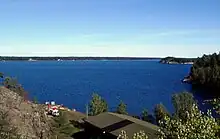Hårsfjärden
The Hårsfjärden, or Horsfjärden (Swedish pronunciation: [ˈhɔ̂ʂːˌfjæːɖɛn]),[1] is a fjard off the Baltic Sea near Stockholm, Sweden. About 20 kilometres (12 mi) long, it has surface area of 61.5 square kilometres (23.7 sq mi).[2] It is the location of three Swedish naval bases: Märsgarn, Muskö, and Berga.

It was the location of the Hårsfjärden incident, during October 1–13, 1982, in which Swedish forces appeared to have trapped a foreign submarine, believed to be Soviet, but the submarine escaped.[3]
Three Swedish destroyers were sunk in the Hårsfjärden in an explosion on 17 September 1941, during World War II. The three destroyers sunk at a naval base on the fjord were Göteborg, Klas Horn and Klas Ugla. Göteborg and Klas Horn were later salvaged and returned to service, while Klas Ugla was scrapped.[4][5]

References
- Jöran Sahlgren; Gösta Bergman (1979). Svenska ortnamn med uttalsuppgifter (in Swedish). p. 12.
- (in Swedish) Horsfjärden. Vatteninformationssystem Sverige.
- Bynander, Fredrik (1998). "The 1982 Swedish Hårsfjärden Submarine Incident". Cooperation and Conflict. SAGE. 33 (4): 367–407. doi:10.1177/0010836798033004002. S2CID 144799578.
- Whitley, M.J. (2000). Destroyers of World War Two: An International Encyclopedia. London: Cassell & Co. p. 249. ISBN 1-85409-521-8.
- Gardiner, Robert; Chesneau, Roger, eds. (1980). Conway's All The World's Fighting Ships 1922–1946. Conway Maritime Press. p. 372. ISBN 0-85177-146-7.